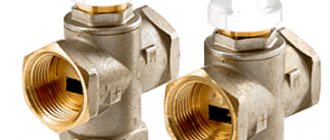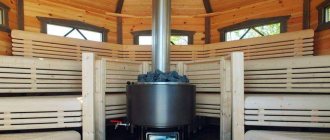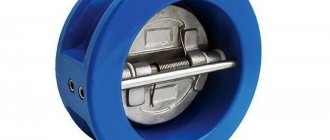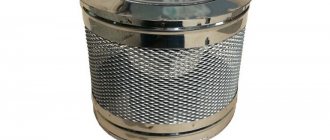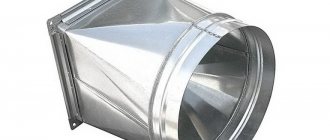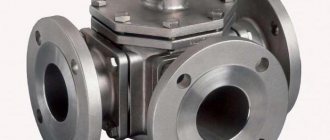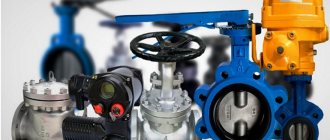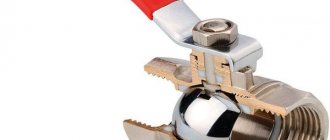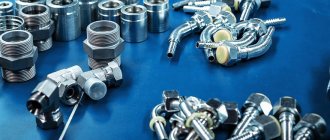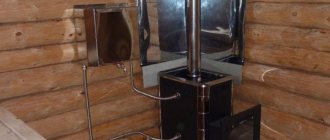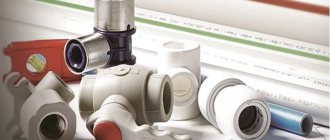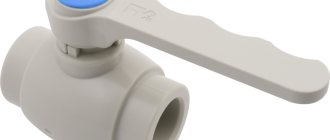Greetings to my dear regular reader! This article is devoted to the story of what a three-way valve with an electric drive is - a type of pipeline fittings that allows you to mix or separate two flows of a medium and regulate the parameters of this mixing using an electric drive and automation.
The world around us strives to minimize the load on humans and even their presence during production processes, and automatic control systems for production and engineering systems of buildings require the use of modern automatic equipment.
What is it and what is it for?
Valve is a type of shut-off valve for pipelines that has three pipes for connection to pipelines. A three-way valve is a control valve that can be used to:
- Regulate the supply of two media simultaneously.
- Control their consumption.
- Completely shut off the pipeline.
The electric drive is used when using three-way valves in automated heating and ventilation systems, industrial devices for supplying chemical reagents, etc. The use of an electric drive is mandatory when operating valves on large-diameter pipelines.
When heating a private home, thermal valves help save heat consumption - with proper heating adjustment, fuel savings can reach 30%.
Having calculated how much it costs to equip radiators with three-way valves and comparing this with financial savings on fuel, we can conclude that it is more profitable to use modern thermostats with an electric drive.
Purpose and scope
Three-way valves are widely used in everyday life and in all sectors of the national economy.
Previously, every house had a mixer - a three-way valve. Now such devices have been replaced by more convenient mixer taps with electric drives. But the engineering communications of houses are constantly becoming more complex, and today it is impossible to do without control valves when organizing modern engineering systems of buildings. Three-way devices in private homes are used mainly to regulate the heating of radiators, heating in general and underfloor heating systems.
They cannot do without three-way valves with an electric drive and a home air conditioning and ventilation system. In recent years, such regulators have been installed on hot water pipelines.
In industry, three-way control valves with an electric drive are indispensable - they are common in many industries that require transportation and dosed supply of gases and liquids. Three-way control valves with electric drive are used:
- In the chemical industry.
- In mechanical engineering.
- In metallurgy.
- At mining and processing enterprises.
- In agriculture.
- In the food industry.
Electrically actuated valves are also used in numerous hydraulic transport pipelines and working equipment (these are available in almost all industries).
Characteristics
Main characteristics of three-way valves:
- Separating or mixing.
- Diameter of pipes for connection.
- Bandwidth.
What materials are they made from?
Materials for the manufacture of three-way valves with electric drive:
- Regular carbon steel. Steel products are strong, cheap, and quite durable. A serious drawback is that steel is susceptible to corrosion. Nickel or chromium plating is used for protection.
- Stainless steel with high chromium and nickel content. Stainless steel is durable, strong, chemically inert (not subject to corrosion). A significant drawback is the high cost.
- Brass is an alloy of copper and zinc. Brass does not rust, is strong, durable, but loses strength already at 200 °C - this limits its use in production.
- Bronze is an alloy of copper and tin (sometimes with aluminum, silicon, beryllium, lead). In terms of technological properties, bronze is similar to brass.
- Titanium. Lightweight and durable material, but expensive.
- Ceramics. New material. Durable, chemically inert, expensive and fragile. So far, it is practically not used for products with electric drives (and regulators in general).
- Cast iron. Archaic, but still found.
- Silumin. Aluminum alloy with silicon additive. There is no quality and durability; it is not used in production. In everyday life, sellers sometimes manage to “sell” an inattentive or super-frugal buyer (so be careful - the stingy one pays twice).
For engineering systems in housing, three-way brass products (less often bronze) are usually used - reliable, durable, stainless and quite affordable.
Table for ordering T-port taps
| Thread, inch | Du, mm | Switching time | Drive power supply | Order code | Price including VAT, rub. |
| 1/4″ | 10 | 12 | 220/AC | 32T6ST1422012 | 22695 |
| 24/AC/DC | 32T6ST1424U12 | 25098 | |||
| 24/DC | 32T6ST1424D12 | 25187 | |||
| 3/8″ | 12 | 12 | 220/AC | 32T6ST3822012 | 22873 |
| 24/AC/DC | 32T6ST3824U12 | 25276 | |||
| 24/DC | 32T6ST38224D12 | 25365 | |||
| 1/2″ | 12 | 12 | 220/AC | 32T6ST1222012 | 23051 |
| 24/AC/DC | 32T6ST1224U12 | 25454 | |||
| 24/DC | 32T6ST1224D12 | 25543 | |||
| 3/4″ | 15 | 12 | 220/AC | 32T6ST3422012 | 23674 |
| 24/AC/DC | 32T6ST3424U12 | 26077 | |||
| 24/DC | 32T6ST3424D12 | 26166 | |||
| 1″ | 20 | 12 | 220/AC | 32T6ST122012 | 24920 |
| 24/AC/DC | 32T6ST124U12 | 27323 | |||
| 24/DC | 32T6ST124D12 | 27412 | |||
| 11/4″ | 25 | 12 | 220/AC | 32T6ST11422012 | 27501 |
| 24/AC/DC | 32T6ST11424U12 | 29904 | |||
| 24/DC | 32T6ST11424D12 | 29993 | |||
| 11/2″ | 32 | 12 | 220/AC | 32T6ST11222012 | 38626 |
| 16 | 24/AC/DC | 32T6ST11224U16 | 41563 | ||
| 16 | 24/DC | 32T6ST11224D16 | 39961 | ||
| 2″ | 40 | 12 | 220/AC | 32T6ST222012 | 59007 |
| 16 | 24/AC/DC | 32T6ST224U16 | 68352 |
Operating principle and device
Three-way valves always have three connections. The principle of operation of mixing valves with an electric drive is to mix two media into one with specified parameters (the desired temperature, the desired chemical composition of gas or liquid). The principle of operation of the separation valve is to redistribute the flow of the medium into two outlets.
In any case, the valve has:
- Body with seat.
- Regulating element (plunger on a rod moving in a vertical direction).
- Seals.
When lowering or lifting, the plunger partially or completely blocks the lumen of the fittings and regulates the flow of the medium (distributes it between two outlets).
Nowadays, more and more often in everyday life, devices based on a faucet are also called three-way valves - its working body has the shape of a ball, segment, cone or cylinder; for adjustment, the working body rotates around its axis. The result for both types of three-way valves is the same, so in the future in the article, for simplicity, I will call such valves with an electric drive the word valve (or valve).
Three-way valve with electric drive
In order to control a three-way valve automatically, an electric drive is installed on it, which allows you to rotate the valve to the required angle.
Control signals are generated by an intelligent device (controller or regulator), examples of which will be discussed below.
The crane drive can be controlled by 220 V or 24 V.
Based on the type of control signal, there are two types of three-way valve drives:
- impulse control drive
- drive with analog signal control 0-10 V or 4-20 mA
Advantages and disadvantages
Advantages and benefits of three-way valves:
- Simple, reliable design ensures durability.
- High tightness (can be used for gas and pneumatic pipelines; this property is especially important when used in the chemical industry).
- Wide range of operating pressures and temperatures - from vacuum to 250 MPa, from -200 to +600 °C.
- Slow wear of sealing elements reduces the need for repairs.
- Easy maintenance and repair.
- Relatively compact dimensions (for example, compared to a gate valve).
Disadvantages of three-way products:
- High hydraulic resistance of three-way structures.
- The design of the housing causes the presence of stagnant zones, which can serve as a place for the accumulation of debris, scale, and impurities.
- The difficulty of adjusting the flow of the medium with manual control, however, manually controlled designs are gradually becoming a thing of the past. Giving way to electric drive.
Dimensions:
| Dimensions (mm) and weight (kg) | |||||||||||
| G" | Du | H1 | H2 | N | W | L | L1 | L2 | D1 | N1 | Weight |
| 1/4″ | 10 | 36 | 149 | 185 | 120 | 127 | 74 | 37 | 10 | 1×1/2″ PF | 2,3 |
| 3/8″ | 12 | 36 | 149 | 185 | 120 | 127 | 74 | 37 | 12 | 1×1/2″ PF | 2,3 |
| 1/2″ | 12 | 36 | 149 | 185 | 120 | 127 | 74 | 37 | 12 | 1×1/2″ PF | 2,3 |
| 3/4″ | 15 | 46 | 149 | 195 | 120 | 127 | 88 | 44 | 15 | 1×1/2″ PF | 2,5 |
| 1″ | 20 | 56 | 149 | 205 | 120 | 127 | 104 | 52 | 20 | 1×1/2″ PF | 2,8 |
| 11/4″ | 25 | 62 | 149 | 211 | 120 | 127 | 120 | 60 | 25 | 1×1/2″ PF | 3,6 |
| 11/2″ | 32 | 73 | 149 | 222 | 120 | 127 | 136 | 68 | 32 | 1×1/2″ PF | 4,9 |
| 2″ | 40 | 85 | 200 | 285 | 168 | 157 | 150 | 75 | 40 | 2×1/2″ PF | 9,2 |
Kinds
Based on their operating principle, three-way valves are divided into:
- Separating.
- Mixing (see photo).
Mixing - mix two media in a certain proportion (for example, hot and cold water). They have two pipes for supplying media and one pipe for outlet. Use in everyday life - for regulating the ambient temperature in underfloor heating systems. For the floor, it is very important to prevent too hot coolant from entering the pipes and overheating the floor. Typically, the three-way version is installed in the collector unit, receives information from several sensors, and operates automatically from an electric drive.
Separation (or distribution) - have one medium input and two outputs. The control element usually does not shut off the coolant current, like a two-way valve, but completely or partially redistributes it between the two terminals.
In everyday life, these are usually thermal valves on radiators and electric valves in heating boiler piping, in heat exchangers in ventilation and air conditioning systems. In any system with a heating device, a bypass and a three-way valve must be installed (when using gas boilers, these components are built into the boiler).
When too hot water arrives, the thermostat is activated by an electric drive, and part of the water is supplied to the bypass - past the radiator. When installed behind the boiler, part of the water is supplied to the bypass and enters the boiler through the return; the thermostat, when hot water enters from the return, turns off the boiler or reduces the heating temperature.
According to the method of actuation, three-way valves are divided into:
- Manual.
- Automatic.
Three-way automatic ones are in turn divided into:
- Thermostatic - triggered by an increase in pressure as the temperature increases. This is the simplest and most inexpensive type of thermal valves; it is most often used for radiators.
- With thermal head - there is a temperature sensor on the valve.
- Electrically driven (turning is done using an electric motor).
The drive can be based on a solenoid (magnet) or an electric motor:
- With mechanical transmission (servo drive).
- With pneumatic or hydraulic drive (used in production in systems with high pressures).
Valve markings
You can see numbers and letters on the three-way valve. The company name is written first. Then - the series and model number (in the example VTA 321). Then the nominal diameter in mm, for example, DN 20. Then the temperature regime, for example 20-43C - regime from 20 to 43 °C. Then the throughput in cubes is KVS 1.6 - 1.6 m³/hour. For example: the complete marking of an ESBE motorized valve is as follows:
ESBE VTA 321 DN 20 20-43C, kvs 1.6
Standard sizes of directional valves (both with and without electric drive): ½", ¾", 1″, 1¼" and so on.
Life time
The service life of shut-off valves largely depends on the operating mode (frequency of operation) and the quality of the thermostat. In any case, you can expect it to last about five years, but if it operates rarely, the three-way valve can last longer. First of all, the thermostat or electric drive fails; the valve itself can last 10 years or more.
Table for ordering L-port valves
| Thread, inch | Du, mm | Switching time | Drive power supply | Order code | Price including VAT, rub. |
| 1/4″ | 10 | 12 | 220/AC | 32L6ST1422012 | 22606 |
| 24/AC/DC | 32L6ST1424U12 | 25009 | |||
| 24/DC | 32L6ST1424D12 | 25098 | |||
| 3/8″ | 12 | 12 | 220/AC | 32L6ST3822012 | 22784 |
| 24/AC/DC | 32L6ST3824U12 | 25187 | |||
| 24/DC | 32L6ST38224D12 | 25276 | |||
| 1/2″ | 12 | 12 | 220/AC | 32L6ST1222012 | 22962 |
| 24/AC/DC | 32L6ST1224U12 | 25365 | |||
| 24/DC | 32L6ST1224D12 | 25454 | |||
| 3/4″ | 15 | 12 | 220/AC | 32L6ST3422012 | 23585 |
| 24/AC/DC | 32L6ST3424U12 | 25988 | |||
| 24/DC | 32L6ST3424D12 | 26077 | |||
| 1″ | 20 | 12 | 220/AC | 32L6ST122012 | 24831 |
| 24/AC/DC | 32L6ST124U12 | 27234 | |||
| 24/DC | 32L6ST124D12 | 27323 | |||
| 11/4″ | 25 | 12 | 220/AC | 32L6ST11422012 | 27412 |
| 24/AC/DC | 32L6ST11424U12 | 29815 | |||
| 24/DC | 32L6ST11424D12 | 29904 | |||
| 11/2″ | 32 | 12 | 220/AC | 32L6ST11222012 | 38359 |
| 16 | 24/AC/DC | 32L6ST11224U16 | 41563 | ||
| 16 | 24/DC | 32L6ST11224D16 | 39961 | ||
| 2″ | 40 | 12 | 220/AC | 32L6ST222012 | 58651 |
| 16 | 24/AC/DC | 32L6ST224U16 | 67996 |
Tips for choosing
Fittings for heating control are quite expensive, so you should not chase the cheapness and buy it on the market or in online stores. It is better to purchase equipment for engineering systems in a construction hypermarket or in specialized stores.
Required availability:
- Certificate.
- Check.
- Guarantees (and stamps on the guarantee or passport with the guarantee).
Before purchasing, decide on the diameters of the connecting pipes (they must be equal to the diameter of the pipes or holes in the radiator plug), and the shape of the valve (T- or L-shaped). The optimal choice of material is brass or stainless steel.
You won’t be able to check the fittings in a store, but be sure to check for damage, cracks, chips, irregular shapes, or wrinkles, especially in the area of the thermostat. If the entire batch of goods has a different shape or defects, look for another store.
Regulating equipment (including electric drives) pays for itself after several years of use, so you should not save much - products of dubious quality will fail quickly, and you will have to buy new thermal heads and three-way valves.
Popular manufacturers
The best quality of three-way valves, including those with an electric drive, is from the products of the Swedish company ESBE. The thoroughness of the Swedes and the more than hundred-year history of the company are proof of this.
In second place is the American company Honeywell. Unfortunately, the price of products from these companies outstrips even their quality.
It is worth mentioning the companies HEIMEIER, HERZ, Navien, Danfoss.
The products of the joint Italian-Russian manufacturer Valtec are somewhat more affordable in price, but no worse in quality.
approximate price
For the thermal valve for the radiator:
For a three-way valve with an electric drive for piping a solid fuel boiler:
Installation and operation rules
Three-way dividing valves with an electric drive are installed in pipelines and radiators using American union nuts with seals.
Thermal valves (no matter with or without electric drive) are very easy to install:
- Mounted into the hole in the plug of the upper radiator hole.
- The bypass is connected to one outlet pipe, and the coolant supply is connected to the other.
The connection of a three-way mixing valve with an electric drive to the heated floor system is made in the manifold cabinet. The supply of hot coolant from the boiler is connected to one inlet pipe, and the cool return flow is connected to the other. Warm water (45 °C) is supplied to the outlet pipe and then to the pump using an electric drive for the heated floor pipeline.
In the piping scheme of a solid fuel boiler, three-way separating valves with an electric drive are also required. When the boiler is turned on, warm water from the supply pipeline is directed through the bypass into the boiler - this protects the boiler chamber from condensation.
As the water warms up to 50-60 °C, the valve gradually adds cold water from the return line to the water entering the boiler. After the system has completely warmed up, the valve switches to supplying return water to the boiler (at a temperature not lower than 50 °C). When the return water cools more strongly, the valve is turned on again by the electric drive and mixes hot water into the return.
Do not allow cold water to enter the combustion chamber of the boiler! In such schemes, valves with an actuator are necessarily used.
Frequent errors and problems during installation
The most common installation mistake is connecting pipelines to the wrong connections. For example:
- Connecting a bypass to the inlet pipe when connecting the thermal valve to the battery.
- The valve location is not in accordance with the arrows indicating water flow.
Typically, such connection errors occur when the type or shape of the electric valve is incorrectly selected.
Expert advice
Electrically driven thermal valves should not be installed on cast iron radiators - they have a very high thermal inertia, and practically adjusting such radiators is pointless. In case of overheating, it is easier to screw on a regular valve at the coolant inlet to the radiator.
Installing thermal valves with a single-pipe heating system and in multi-storey buildings is quite ineffective (we don’t heat until it gets hot, and if it happens, it’s easier to temporarily cover the radiator with a blanket or cardboard).
But connecting underfloor heating pipes without a three-way valve can lead to very unpleasant consequences - overheating of the system and floor structures (in some cases, even cracking of the screed).
Even more unpleasant consequences are the absence of an electric valve in the piping system of a solid fuel boiler. The ingress of cold water from the return into the combustion chamber of a solid fuel boiler will lead to condensation on the heat exchanger and the walls of the boiler and, as a result, will quickly disable the boiler.
